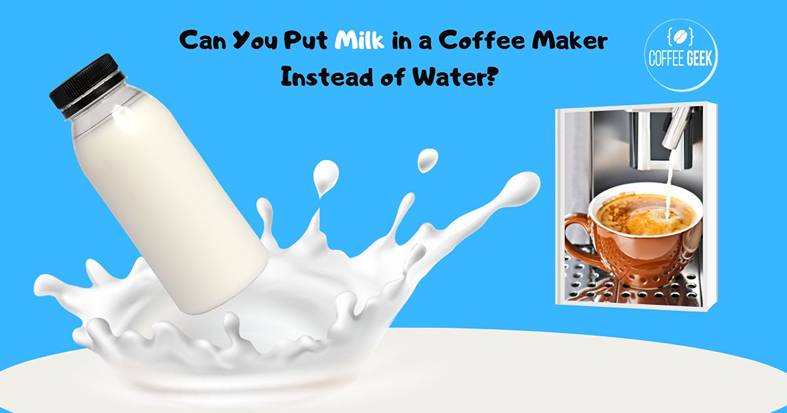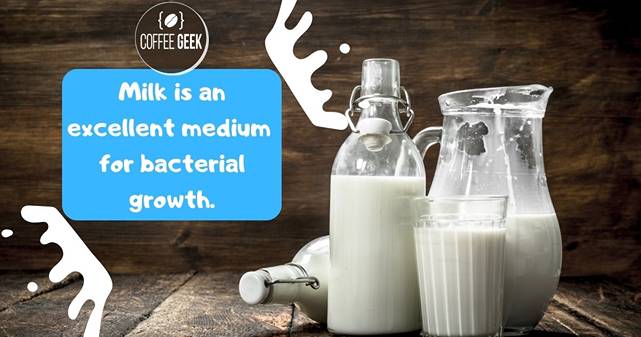Have you ever wondered “can you put milk in a coffee maker instead of water?” Can you put milk in a coffee maker?
If brewing coffee with milk instead of water has piqued your interest, we’ve gathered all the essential information you’ll need to know.
Let’s dive into a deeper understanding why adding milk to you standard coffee maker could be recipe for disaster.
Can You Put Milk in a Coffee Maker? Why Putting Milk in a Coffee Maker Instead of Water is a Bad Idea!
Coffee makers have been a staple in kitchens worldwide, helping people get their daily caffeine fix.
However, occasionally, adventurous souls may wonder: can you put milk in a coffee maker instead of water?

At first glance, the idea might sound tempting. After all, who wouldn’t want a creamy latte or cappuccino at the push of a button?
But, unless you’re using a specialty machine designed for such purposes, this experiment can lead to disappointing, if not disastrous results.
1. Milk Can Scorch and Burn
The primary concern is that milk can scorch easily. Most coffee makers are designed to heat water to a specific temperature optimal for brewing coffee.
Milk, with its sugars and proteins, behaves differently than water when heated. It can scorch and burn, leaving you with a burnt taste rather than the creamy coffee you might have been expecting.

2. Cleanup Nightmare
Milk leaves behind residues that water does not. If you’ve ever boiled milk on the stove, you’re familiar with the skin that can form.
Now, imagine that skin and other residues clinging to the inner workings of your coffee machine. Cleaning up after such an escapade can be a tedious task.
3. Potential for Bacterial Growth
Milk is an excellent medium for bacterial growth. Any remnants of milk left behind in the machine could lead to mold and bacteria, posing a risk to your health the next time you brew a cup.

4. Damage to the Machine
Using milk can potentially damage the coffee maker. The thickness and consistency of milk can strain the pump and other internal components of the machine not designed to handle such viscosity.
Over time, this can wear out the device or cause it to malfunction.
The Exception
Now, while the above reasons make it clear why using milk in a standard coffee maker is a no-go, there’s an exception. When can you put milk in a coffee maker?
Some high-end automatic coffee machines come with separate reservoirs specifically designed for milk.
These machines are built to handle and froth milk, ensuring that it doesn’t scorch, and they can be easily cleaned. If you’re using such a machine, then you’re in the clear.
But if you have a standard drip coffee maker or even most espresso machines, stick to water and add milk separately after brewing.

| Question | Answer |
|---|---|
| Can you put milk in a coffee maker? | It is not recommended. |
| Why not? | Milk can scorch and clog the coffee maker. |
| What happens if you do? | It may damage the machine, create a mess, and produce burnt milk residue. |
| Are there alternative methods? | Yes, you can froth milk separately and add it to your coffee. Using a milk frother or steamer is a safer option. |
| Can you use milk pods or creamers? | Some coffee makers have options for milk pods or creamers, which are designed to work safely with the machine. Check your coffee maker’s user manual. |
| Any tips for making milk-based coffee? | Heat milk separately, froth it, and add it to your coffee afterward. Alternatively, use a specialized milk frother or steamer for better results. |
Alternative methods to incorporate milk in your coffee
If you’re not comfortable putting milk directly into your coffee maker, there are still plenty of alternative methods to incorporate milk in your coffee.
How to steam milk for your coffee with a milk frother?
One such method is to steam the milk separately using a milk frother. This tool, specifically designed to froth milk, creates the perfect frothy, creamy, steamed milk to add to your cup of coffee.

Add milk to your cup of coffee: A safer method?
Another popular, less risky method is directly adding milk to your coffee after brewing it with water.
You can heat your milk separately, add it to your coffee, and relish the wonderful combination of flavors that milk and coffee create.

Exploring using milk in your coffee: hand-brewed methods
You can also explore hand-brewed methods, which involves frothing or steaming the milk separately and then combining it with your brewed coffee. This gives you more control over the flavor and texture of the final result.
How does the type and amount of milk affect the taste of coffee?
Each type of milk carries its own distinct flavor profile that can dramatically influence your coffee. Let’s explore how the type and amount of milk may change the taste of your coffee.
Understanding how different types of milk contains varying flavor profiles
Different types of milk – from whole milk to almond milk – contains different proteins and fats that could change the taste of your coffee.
Take note of the type of milk you’re using, the amount, and how it affects the taste and texture of your coffee.
Optimizing the amount of milk for perfect taste
The amount of milk can also greatly influence the taste.
Additionally, the coffee-to-milk ratio can be adjusted based on personal taste – some people may prefer a stronger coffee flavor, while others may enjoy a creamier, milder coffee drink.
Don’t be afraid to experiment and find what makes your coffee taste best for you.
Impact of coffee beans on the flavor when using milk instead of water
Keep in mind that the type of coffee beans you use may react differently when brewed with milk instead of water.
Some beans may offer a rich, full-bodied flavor when brewed with milk, while others may lose their unique profiles. Further tests, trials and tweaks can lead you to your perfect cup of coffee.
To Conclude
While the idea of brewing coffee directly with milk might sound intriguing, it’s best left to the imagination unless you have the right equipment.
Stick to the traditional method, and you’ll ensure a great-tasting cup every time, with the bonus of prolonging the life of your coffee machine.
Q&A
Can you really put milk in a coffee maker?
Technically, you could put milk in your coffee maker, but it’s definitely not recommended. Coffee makers are designed to make brewed coffee by heating up water to extract flavor from coffee beans.
Introducing milk to your coffee maker could lead to clogs and hard-to-clean messes.
What happens when you use milk instead of water in a coffee machine?
Milk doesn’t behave like water in a coffee machine. When heated to high temperatures, milk can easily curdle, stick to the machine’s interior and lead to significant build-up that could ruin your machine over time.
It’s best to use water in a coffee maker and add milk afterwards if desired.
Could I use milk in a coffee machine instead of water for a richer flavor?
It’s great that you’re looking for a richer flavor, but putting milk in a coffee machine instead of water isn’t the way to go because milk can clog and damage your machine.
To achieve a richer flavor, consider using fresh coffee beans, ideally arabica beans instead of robusta beans. You can also add a small amount of milk or cream after brewing your coffee.
Can I add milk directly when brewing in my coffee maker?
Adding milk directly while brewing in a coffee maker is not advised. Milk could potentially harm your coffee maker due to its fats and proteins that are not designed for being heated in such a manner.
It’s better to brew your coffee using water, and then add milk to your cup after.
Is it possible to steam milk using a coffee maker?
A: Most standard coffee makers are not built to steam milk. However, espresso machines often have this feature.
Some coffee makers might also have integrated milk frothers, which can help you achieve that steamed milk and milk foam you desire.
Can you use milk in a coffee machine to make milk-based coffee?
No, you should make your coffee with water first and then add milk. This is because dual-purpose coffee and espresso makers can create milk-based coffee drinks by adding steamed milk to freshly brewed espresso.
A regular coffee maker, however, is specifically designed to make brewed coffee by heating up water.
Can I use milk in an espresso machine instead of water?
No, an espresso machine works by using pressure to force hot water through coffee grounds.
If you try to use milk in an espresso machine instead of water, it could cause issues with the pressure and temperature, potentially damaging your machine.
Is it possible to put milk in the coffee maker if I use a small amount?
Even if you use a small amount of milk, it’s not advisable to put milk in the coffee maker. Milk components when heated in a coffee machine can still lead to blockages and potentially damage the machine.
Can I add a lot of milk after brewing coffee in a coffee maker?
Yes, you can add as much milk as you like to your coffee after it’s been brewed. It’s how cappuccinos and lattes are made—with a lot of milk added after the coffee has been brewed.
Could you use milk instead of water in a coffee maker for lactose intolerant person?
No, even for a lactose-intolerant person, it would not work.
Milk in a coffee maker can potentially damage your machine, even if the milk is lactose-free. Instead, Brew your coffee with water and add lactose-free milk or a non-dairy alternative in the cup.

